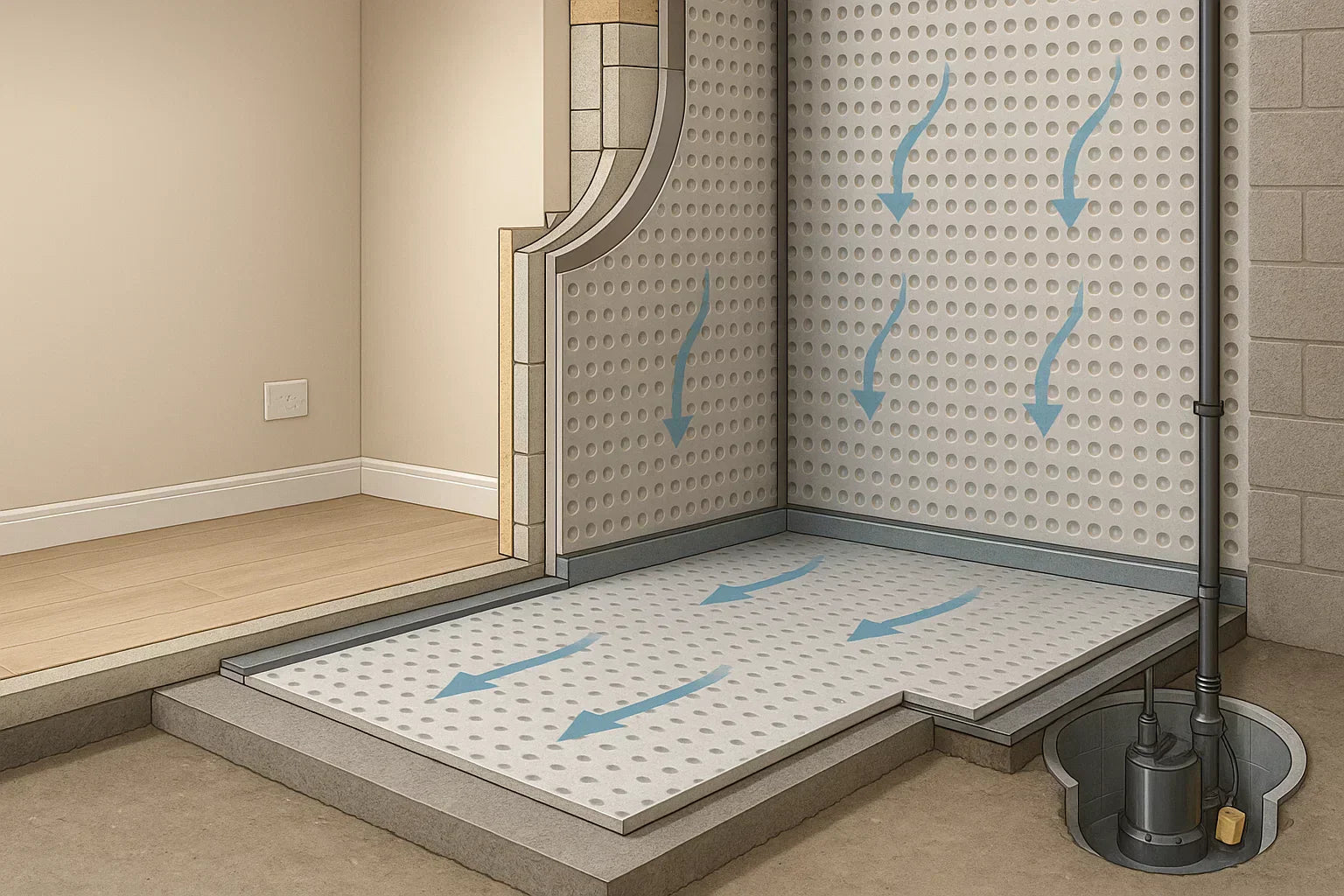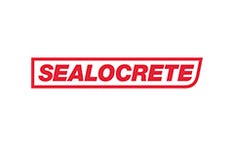When protecting basements, cellars or damp-prone walls from water ingress, few systems are as versatile or trusted as the cavity drainage membrane (CDM). It’s widely used across the UK in both domestic and commercial refurbishments, providing a highly effective way of managing moisture without relying on rigid waterproof barriers that can fail over time.
Whether you're converting a basement, restoring an old building, or simply addressing persistent damp issues, choosing the right membrane is crucial. With options ranging from ultra-thin wall linings to heavy-duty floor membranes, understanding the system and its components will help you make the right decision—and achieve a long-lasting, dry finish.

What Is a Cavity Drainage Membrane?
A cavity drainage membrane is a high-density polyethylene (HDPE) sheet engineered with a dimpled or studded profile. These raised studs create a void between the membrane and the structural substrate, allowing water to move freely behind the surface. The system is designed to collect, direct, and evacuate moisture through a drainage system, rather than trying to stop water at the point of entry.
Classified under Type C waterproofing as per BS 8102, CDM systems are unique in that they accept the presence of water within the structure and manage it safely, making them especially reliable in below-ground environments or buildings prone to intermittent dampness.
This method is particularly well suited for older or heritage properties where impermeable coatings would be unsuitable or damaging. The membranes are vapour-permeable, highly durable, and in most cases reversible, meaning the original structure remains intact beneath.

How the System Works
A cavity drainage system functions through passive water management:
- The membrane is installed onto internal walls or floors using sealed fixing plugs.
- Moisture entering the building is captured in the air gap behind the membrane.
- Water then flows by gravity into perimeter drainage channels located at the wall–floor junction.
- From there, it’s either guided to an external drain or collected in a sump chamber and pumped out.
Because it manages water rather than resisting it, the system continues to work even if minor cracks appear in the substrate or hydrostatic pressure increases. It is not only more forgiving than tanking systems but often quicker to install and easier to maintain.

Applications and Performance Benefits
Cavity drainage membranes can be used in a variety of settings:
- Basement waterproofing
- Damp wall remediation in older homes
- Vaulted or irregular structures
- Above-ground damp control as part of dry-lining
- Heritage property protection
They are highly durable (often with 30+ year guarantees), low maintenance, and compatible with finishes ranging from plaster to plasterboard.
Which Type of Cavity Drainage Membrane Do You Need?
Each membrane type is designed for a specific scenario. Here's what you should consider:
Ultra-Slimline 1mm Membranes
A relatively new but fast-growing option in the industry is the 1mm micro-profile membrane. This ultra-thin material is designed for above-ground damp-proofing where a full air-gap system is not required but some form of moisture barrier or separation is essential.
These membranes are particularly useful in:
- Period homes where minimal intervention is required
- Timber floor protection from rising damp
- Lining walls with minor condensation or low-level damp
- Applications behind insulation boards or timber cladding
At only 1mm thick, they are virtually invisible once installed and are compatible with most internal finishes. While not suitable for below-ground tanking or heavy water ingress, they are ideal for dry-lining applications, separation layers, or hybrid systems.
If you're renovating a domestic room that suffers from light dampness or condensation—but isn’t actively leaking—this could be your most discreet and cost-effective solution.
Slimline 3–5mm Membranes
Slightly thicker than the 1mm range, slimline membranes still offer a space-saving design but with increased capacity for moisture movement. These are often used where the substrate is uneven or prone to damp but does not require full basement-grade protection.
They work well in older homes with lime plaster or solid walls, and can be installed behind battens or with direct fixing methods. While not always plaster-ready, they make an excellent base for overboarding or mechanical fixing systems.
Standard 8mm Wall Membranes
The most common choice for basement or cellar wall waterproofing, the 8mm studded membrane offers a reliable balance of drainage capacity, mechanical strength, and ease of use. These membranes are often available in two variants:
- Clear membrane (no mesh): Designed for use behind timber studwork or metal framing systems. Once installed, the wall can be insulated and finished without direct contact with the substrate.
- Mesh-faced membrane: These have a bonded surface layer that provides a mechanical key for direct plastering or dot-and-dab plasterboard. Ideal for residential basements where internal finishes must remain flush and seamless.
Mesh membranes are a popular choice because they reduce build-up and don’t require battening, allowing you to achieve a clean, dry wall in less time.
Heavy-Duty 20mm Floor Membranes
For basement floors or areas subject to persistent or high-volume water ingress, 20mm membranes offer superior drainage performance. These products have large-profile studs that create a significant void beneath the slab or floor surface.
They are typically used in combination with insulation, screed, or floating floor systems and are essential when water ingress from below is anticipated. Floor membranes should be lapped up to meet wall membranes and sealed properly using jointing tape and pre-formed corner strips to ensure continuity.

Recommended Accessories for Each Membrane Type
To ensure a watertight and long-lasting installation, each type of cavity drainage membrane requires compatible accessories. Using the correct fixings, tapes, and sealing systems is essential for proper performance and to comply with best practice standards.
Ultra-Slimline 1mm Membranes
- Application: Typically bonded with double-sided butyl tape or fixed using micro-profile plugs, depending on the substrate.
-
Recommended accessories:
- Butyl sealing tape (50mm or 100mm)
- Joint tape for overlapping sheets
- Optional: mechanical fixings for uneven surfaces
Slimline 3–5mm Membranes
- Application: Fixed to solid walls with slimline fixing plugs at regular intervals (typically 250mm centres).
-
Recommended accessories:
- Slimline membrane fixing plugs with sealing washers
- Butyl rope for plug sealing (optional for extra security)
- Overseal tape for edges and joints
Standard 8mm Wall Membranes
- Application: Mechanically fixed to internal basement or cellar walls using sealed plugs. Mesh-faced versions support direct plastering.
-
Recommended accessories:
- Membrane fixing plugs with integrated rubber seals
- Butyl rope or mastic for plug heads (especially in wet areas)
- Mesh-compatible plaster or adhesive (for mesh membranes)
- Sealing tape or fleece tape for horizontal and vertical overlap
Heavy-Duty 20mm Floor Membranes
- Application: Loose-laid on floor slabs, lapped at edges and sealed using compression or fleece tape. Integrated with perimeter drainage.
-
Recommended accessories:
- Fleece-backed jointing tape (for overlapped seams)
- Corner sealing strips
- Pre-formed internal and external corner pieces
- Perimeter drainage channels with inspection ports
- Sump and twin-pump system with battery backup

View Cavity Drainage Membrane Accessories (Plugs & Tapes).
A Complete Waterproofing System
For basements and underground structures, a full CDM installation typically includes:
- 8mm wall membranes
- 20mm floor membranes
- Perimeter drainage channels
- Sump and pump systems
- Sealing tapes, plugs, and corner profiles
Proper detailing and continuity are essential—every join, corner, and fixing must be sealed to ensure long-term performance.

CDM vs Tanking: A Smarter Approach
Tanking systems aim to block water. But if hydrostatic pressure builds or the substrate moves, they can crack and fail. Cavity membranes offer a more forgiving approach. They allow moisture in, then guide it away. This approach is often more reliable, especially in older buildings or fluctuating water tables.
Choosing the Right System for Your Project
Ask yourself:
- Is the structure above or below ground?
- Is the water issue light damp or active ingress?
- Do you need to plaster, overboard, or install studwork?
- Is there enough space for thicker systems?
- Do you have an outlet or pump for drainage?
For light dampness, 1mm or slimline membranes may suffice. For full waterproofing, use 8mm and 20mm membranes with a proper drainage strategy.
Professional Products from DIY Refurb
We stock a complete range of membranes and accessories, including:
- 1mm, 3mm, 5mm, 8mm and 20mm membranes
- Mesh-faced membranes for plaster finishes
- Drainage channels, sump kits and pumps
- Fixings, jointing tapes, and pre-formed corners
Comparison Table: Which Cavity Drainage Membrane Is Right for You?
This table summarises the key features of each membrane type to help you choose the right product based on thickness, application area, intended finish, and typical use case.
| Membrane Type | Thickness | Application Area | Finish Compatibility | Best Suited For |
|---|---|---|---|---|
| Ultra-Slimline 1mm | 1mm | Above ground (walls, floors) | Behind dry-lining, timber, or insulation | Light damp, separation layers, heritage work |
| Slimline 3–5mm | 3–5mm | Above ground (uneven or solid walls) | Overboarded, battened, or framed systems | Damp solid walls, internal retrofits |
| Standard Wall 8mm | 8mm | Below ground walls (basements, cellars) | Mesh (plaster/render) or clear (battened) | Basement conversions, full waterproofing |
| Heavy-Duty Floor 20mm | 20mm | Below ground floors | Screed, floating floor, or insulation over | High water ingress, sump/pump systems |
Final Thoughts
Cavity drainage membranes provide a robust and flexible solution for managing moisture in homes, basements, and historic buildings. From discreet 1mm damp-proofing sheets to 20mm floor membranes that handle substantial ingress, there’s a system suited to your needs. And with professional-grade products and advice from DIY Refurb, you can tackle your next waterproofing job with confidence.



















